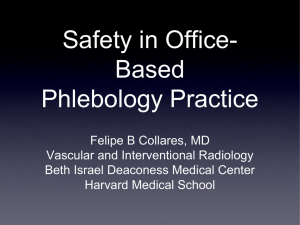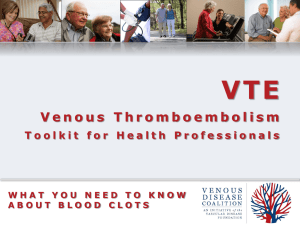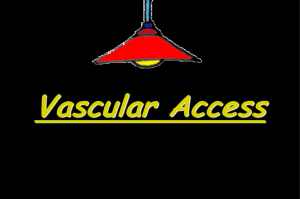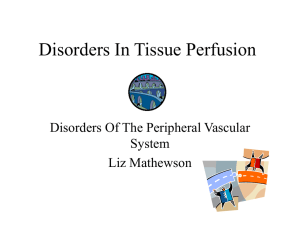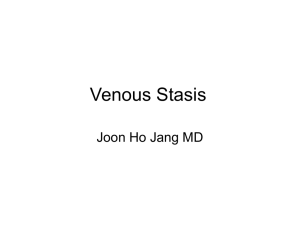toe-walking-2004 - Dr. Benjamin Domb, MD
advertisement
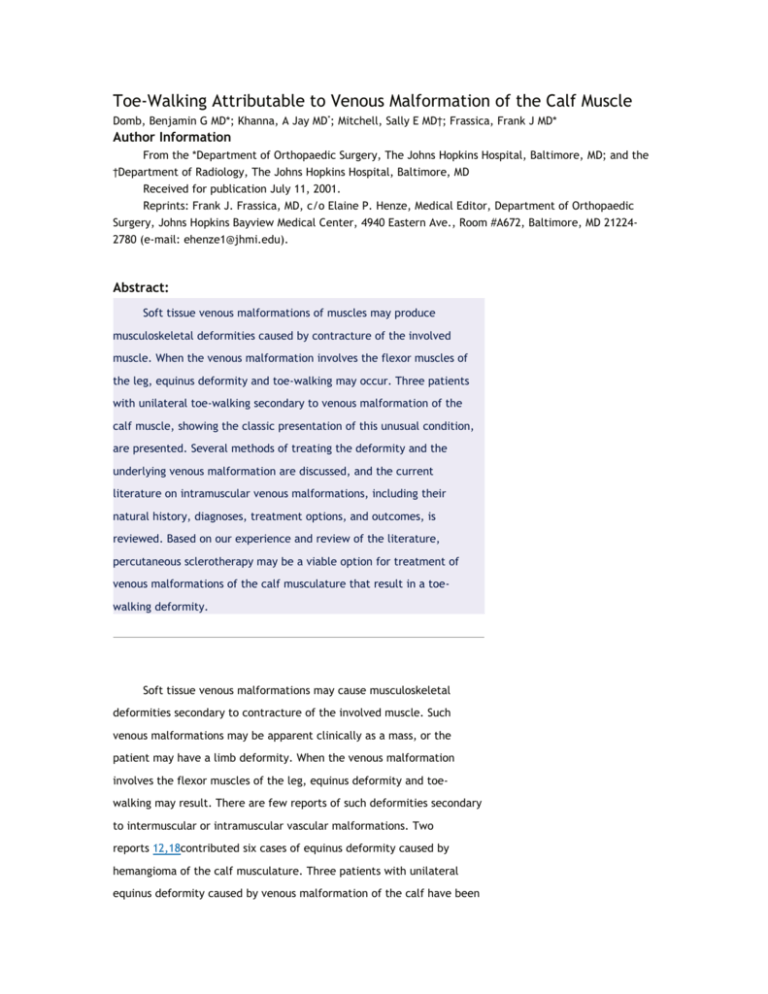
Toe-Walking Attributable to Venous Malformation of the Calf Muscle Domb, Benjamin G MD*; Khanna, A Jay MD*; Mitchell, Sally E MD†; Frassica, Frank J MD* Author Information From the *Department of Orthopaedic Surgery, The Johns Hopkins Hospital, Baltimore, MD; and the †Department of Radiology, The Johns Hopkins Hospital, Baltimore, MD Received for publication July 11, 2001. Reprints: Frank J. Frassica, MD, c/o Elaine P. Henze, Medical Editor, Department of Orthopaedic Surgery, Johns Hopkins Bayview Medical Center, 4940 Eastern Ave., Room #A672, Baltimore, MD 212242780 (e-mail: ehenze1@jhmi.edu). Abstract: Soft tissue venous malformations of muscles may produce musculoskeletal deformities caused by contracture of the involved muscle. When the venous malformation involves the flexor muscles of the leg, equinus deformity and toe-walking may occur. Three patients with unilateral toe-walking secondary to venous malformation of the calf muscle, showing the classic presentation of this unusual condition, are presented. Several methods of treating the deformity and the underlying venous malformation are discussed, and the current literature on intramuscular venous malformations, including their natural history, diagnoses, treatment options, and outcomes, is reviewed. Based on our experience and review of the literature, percutaneous sclerotherapy may be a viable option for treatment of venous malformations of the calf musculature that result in a toewalking deformity. Soft tissue venous malformations may cause musculoskeletal deformities secondary to contracture of the involved muscle. Such venous malformations may be apparent clinically as a mass, or the patient may have a limb deformity. When the venous malformation involves the flexor muscles of the leg, equinus deformity and toewalking may result. There are few reports of such deformities secondary to intermuscular or intramuscular vascular malformations. Two reports 12,18contributed six cases of equinus deformity caused by hemangioma of the calf musculature. Three patients with unilateral equinus deformity caused by venous malformation of the calf have been seen by the authors. This review describes three cases, reviews the relevant literature, and discusses sclerotherapy as a treatment modality for this lesion. Back to Top MATERIALS AND METHODS Percutaneous sclerotherapy to occlude venous malformations was done in the current patients by ultrasound-guided access to the lesion, followed by fluoroscopic-guided injection of the lesion with contrast to confirm intravascular placement of the needle. After assessing the lesion and any possible venous connections, dehydrated absolute ethanol mixed with a small amount (20% by volume) of ethodiol for observation was injected. The mixture was allowed to sit for 20 minutes to sclerose, followed by recheck with contrast and reinjection of ethanol if the flow remained in the venous malformation. Magnetic resonance imaging was used for guidance in one patient because of the difficulty in finding the lesion using ultrasound, but although MRI was good for initial observation of the venous malformation, the resolution was not adequate to confirm intravascular position of the needle, which requires fluoroscopy. Back to Top CASE REPORTS Back to Top Patient 1 A 12-year-old girl presented with a 1-year history of increasing right calf pain and several months of progressive right-side toe-walking. Physical examination revealed marked toe-walking in the right leg and a 10° equinus deformity of the right ankle. There was a palpable tender mass in the right medial calf that did not transilluminate and had no bruit. Radiographs of the leg and ankle were normal. Magnetic resonance imaging scans showed a 3.5 × 2.0 × 6.0-cm mass in the medial head of the right gastrocnemius muscle. The mass showed heterogeneous and serpentine increased T2 signal compatible with a venous malformation (Fig. 1). The patient had a sclerosing procedure that provided excellent symptomatic relief. She had myofascial Figure 1 lengthening of the right gastrocnemius-soleus tendon with excellent results. Back to Top Patient 2 An 11-year-old girl presented with toe-walking and a painful soft tissue mass in the medial head of the gastrocnemius of her right leg. An open biopsy led to the diagnosis of venous malformation. After resection and two serial short-leg casts worn for 1 month each, the patient achieved 10° dorsiflexion of the ankle and good heel strike with gait. Six months later, the toe-walking and a plantar flexion contracture of 10° to 15° had returned, and lengthening of the medial gastrocnemius was done. Four months later, toe-walking and pain began to reappear, and MRI scans showed evidence of recurrence of the venous malformation. After attempted sclerotherapy with ultrasound guidance provided insufficient observation of the malformation, MRI-guided sclerotherapy was done. The pain resolved, although a mild flexion contracture remained. Six months later, increased pain and persistence of the contracture despite physical therapy prompted repeat MRI, which showed continued presence of the venous malformation. The patient subsequently had a second MRI-guided sclerotherapy procedure (Fig. 2). She had a third ultrasound and fluoroscopic-guided treatment with moderate improvement in pain. Because of continued pain and toewalking, she had surgical resection of the medial head of the gastrocnemius, with good pain relief for approximately 1 year. However, because of recurrent venous malformation seen on MRI and recurrent pain, treatment with a higher resolution ultrasound guidance percutaneous sclerotherapy is planned. Back to Top Patient 3 A 5-year-old girl with a history of a venous malformation of the thigh presented with toe-walking, pain that was greatest in the morning, and a small mass in the left distal calf. Findings on MRI scans were consistent with the diagnosis of venous malformation in the flexor digitorum longus and tibialis posterior muscles. After an initial attempt at sclerotherapy was terminated because of extravasation of contrast Figure 2 material, the second attempt was successful and resulted in resolution of her pain and flexion contracture. During the 30 months since sclerotherapy, a small venous malformation developed anterior to the distal tibia associated with only mild pain. The patient’s physical therapy was very successful, and she has had no recurrence of flexion contracture or pain in the posterior leg. Back to Top DISCUSSION Intramuscular venous malformations have been described 2,14,16,17,20 but are rare, comprising only 0.8% of all venous malformations.20 A venous malformation is a benign and common malformation consisting of anomalous venous sacs with variable connection to the normal venous system. They may occur in capillary or cavernous variants anywhere in the body. Venous malformations may present in numerous ways. Two common presenting complaints are pain and a palpable mass.12,17,18 These complaints may occur together or independently. Less common presentations are growth disturbance causing limb length discrepancy 13 and hemarthrosis. A retrospective review of 41 patients with hemangioma of the extremities indicated that 22 patients presented with a mass, 11 had limb length discrepancies, and two had recurrent joint effusions.17 Most venous malformations follow a relatively benign course, but they grow with the patient’s growth, and increased periods of growth can occur during puberty or pregnancy. Treatment is usually necessary for pain, bleeding via lesions extending through the skin, hemarthrosis, or cosmetic purposes. Acquired equinus deformity of the ankle is an uncommon complaint that only rarely has been described as the presenting complaint of venous malformation of the flexor muscles of the leg.12,18 This presentation may be accompanied by pain or a mass, or it may present as subtle and progressive toe-walking. In the latter case, diagnosis may be difficult, and benign tumor of the calf muscles must be included in the differential diagnosis. Clinical tests that may aid in diagnosis include application of a venous tourniquet proximal to the lesion, which may cause increased swelling and pain, and extension of the knee, which results in increased plantar flexion of the ankle if the gastrocnemius is involved. However, definitive diagnosis relies primarily on MRI. The characteristic finding of a venous malformation seen on MRI scans is a soft tissue mass with serpentine areas of signal void shown equally well on T1- and T2weighted images.5,11 The serpentine areas show flow voids within large or small blood vessels.1,4,7 Variable amounts of fat signal also are seen in hemangiomas.7Punctate and retinacular areas of lower signal intensity in the lesion also may represent fibrous tissue, smooth muscle components, calcification, or ossification.11 MRI provides a definitive diagnosis and should facilitate preoperative planning. Radiographs usually are normal, but they may reveal soft tissue swelling or phleboliths.12 Patients with venous malformations may be treated with medical therapy, surgical resection, or percutaneous embolization (sclerotherapy). The traditional treatment for soft tissue venous malformations is surgical resection. Wide resection is optimal, but it may be impeded by the location, depth, and accessibility of the lesion, necessitating subtotal resection. Surgical resection also is technically challenging because of infiltration of adjacent structures and difficulty in identifying the location and margins of the venous malformation after a tourniquet has been applied. In addition, blood loss can be substantial if surgery is done without a tourniquet.15 Despite these limitations, surgical treatment has resulted in satisfactory outcomes for patients with toe-walking secondary to venous malformation of the calf muscle.12,18 Transcatheter arterial embolization is not useful because there is usually little supply from the arteries. Venous malformations must be approached percutaneously because they do not fill from contrast injection of normal arteries and veins. Their connections to the normal venous system are minor and variable. Percutaneous embolization using sclerosants results in thrombosis by denaturing blood proteins, by damaging vessel wall endothelial cells, and by eroding the endothelium to the internal elastic lamina. This inflammatory reaction subsequently is replaced by fibrous connective tissue.3,9,10,15 Successful sclerotherapy of a vascular lesion is predicated on the extended contact of the concentrated agent with the endothelial lining of the vessel. Multiple agents have been used successfully to sclerose venous malformations. Of these agents, ethanol probably is the most commonly used.15,21–23 Other agents that have been used successfully include ethodiol, sodium tetradecyl sulfate, doxycycline, and combination therapy.6,8,9,19 The preferred technique at our institution is percutaneous imageguided injection of the lesion with ethanol. This procedure is done under guidance of ultrasound for access, followed by fluoroscopy for intravascular accuracy, as detailed in the Materials and Methods section. Although percutaneous sclerotherapy is less invasive than excision or embolization, substantial potential complications do exist. The most common complication is local tissue injury, including dermal necrosis and peripheral nerve damage.10,15,21,22 The outcomes reported in the literature of sclerotherapy for hemangiomas have been encouraging. O’Donovan et al 15 treated 21 hemangiomas and venous malformations with percutaneous injection of sodium tetradecyl sulfate, with the results being judged beneficial in 86% (18 of 21) of the patients. Dubois et al 6reported excellent results in 74% of 38 patients treated using a similar agent and similar techniques. O’Donovan et al 15 also evaluated the efficacy of sclerotherapy alone versus sclerotherapy combined with surgery and found no significant difference. However, they reported that occasionally multiple sclerotherapy procedures are required to achieve a satisfactory outcome. Of the 21 patients they evaluated, nine required more than one sclerotherapy procedure and four required more than four procedures· The recurrence rate after sclerotherapy is comparable with that after surgical resection. Rogalski et al 17 evaluated 21 patients who had resection of hemangiomas and found that 10 (48%) had recurrences develop. There were 20 recurrences in these 10 patients, nine in the four patients with hemangioma of the leg and 11 in the six patients with hemangioma of the arm.17 These data show that surgical excision does not yield a lower risk of recurrence than sclerotherapy. The less invasive nature of the sclerotherapy procedure with muscle conservation makes it a useful alternative to surgery for treatment of soft tissue venous malformations. When evaluating the patient with unilateral toe-walking, the possibility of a venous malformation of a calf muscle should be considered. The diagnosis can be made by the characteristic MRI findings described above. If the decision is made to proceed with invasive treatment, the option of percutaneous sclerotherapy may be offered as a means of treating the venous malformation in the hope of resolving the equinus ankle deformity. Back to Top REFERENCES 1. Buetow PC, Kransdorf MJ, Moser RP Jr, et al. Radiologic appearance of intramuscular hemangioma with emphasis on MR imaging. AJR Am J Roentgenol. 1990;154:563–567. Discover Full Text@UIUC Internet Resources Bibliographic Links Library Holdings [Context Link] 2. Chauhan ND, Baird BStC: Skeletal muscle haemangioma: An unusual case and a short review of the literature. J Irish Med Assoc. 1973;66:291–293. Discover Full Text@UIUC Bibliographic Links Library Holdings [Context Link] 3. Cho KJ, Williams DM, Brady TM, et al. Transcatheter embolization with sodium tetradecyl sulfate: Experimental and clinical results. Radiology. 1984;153:95–99.Discover Full Text@UIUC Internet Resources Bibliographic Links Library Holdings [Context Link] 4. Cohen EK, Kressel HY, Perosio T, et al. MR imaging of soft-tissue hemangiomas: Correlation with pathologic findings. AJR Am J Roentgenol. 1988;150:1079–1081.Discover Full Text@UIUC Internet Resources Bibliographic Links Library Holdings [Context Link] 5. Cohen JM, Weinreb JC, Redman HC. Arteriovenous malformations of the extremities: MR imaging. Radiology. 1986;158:475–479. Discover Full Text@UIUCInternet Resources Bibliographic Links Library Holdings [Context Link] 6. Dubois JM, Sebag GH, De Prost Y, et al. Soft-tissue venous malformations in children: Percutaneous sclerotherapy with Ethibloc. Radiology. 1991;180:195–198.Discover Full Text@UIUC Internet Resources Bibliographic Links Library Holdings [Context Link] 7. Frassica FJ, Thompson RC Jr. Evaluation, diagnosis, and classification of benign soft-tissue tumors. Instr Course Lect. 1996;45:447– 460. Discover Full Text@UIUCBibliographic Links Library Holdings [Context Link] 8. Gomes AS. Embolization therapy of congenital arteriovenous malformations: Use of alternate approaches. Radiology. 1994;190:191– 198. Discover Full Text@UIUCInternet Resources Bibliographic Links Library Holdings [Context Link] 9. Govrin-Yehudain J, Moscona AR, Calderon N, et al. Treatment of hemangiomas by sclerosing agents: An experimental and clinical study. Ann Plast Surg. 1987;18:465–469. Discover Full Text@UIUC Internet Resources Bibliographic Links Library Holdings [Context Link] 10. Griggs TJ, Andrews JC, Cho KJ, et al. Sciatic nerve injury following internal iliac artery occlusion with Sotradecol and alcohol: A histopathologic study in dogs.J Intervent Radiol. 1989;4:23–26. Discover Full Text@UIUC Library Holdings[Context Link] 11. Hawnaur JM, Whitehouse RW, Jenkins JPR, et al. Musculoskeletal haemangiomas: Comparison of MRI with CT. Skeletal Radiol. 1990;19:251–258.[Context Link] 12. Klemme WR, James P, Skinner SR. Latent onset unilateral toewalking secondary to hemangioma of the gastrocnemius. J Pediatr Orthop. 1994;14:773–775.Discover Full Text@UIUC Internet Resources Bibliographic Links Library Holdings [Context Link] 13. Mikola E, Yang Z, Merkel K, et al. A 7-year-old girl with a growth disturbance in the extremities. Am J Orthop. 1995;24:360–363. Discover Full Text@UIUCBibliographic Links Library Holdings [Context Link] 14. Nack J, Gustafson L. Intramuscular hemangioma: Case report and literature review. J Am Podiatr Med Assoc. 1990;80:441–443. Discover Full Text@UIUCInternet Resources Bibliographic Links Library Holdings [Context Link] 15. O’Donovan JC, Donaldson JS, Morello FP, et al. Symptomatic hemangiomas and venous malformations in infants, children, and young adults: Treatment with percutaneous injection of sodium tetradecyl sulfate. AJR Am J Roentgenol. 1997;169:723–729. Discover Full Text@UIUC Internet Resources Bibliographic Links Library Holdings [Context Link] 16. Paley D, Evans DC. Angiomatous involvement of an extremity: A spectrum of syndromes. Clin Orthop. 1986;206:215–218. Discover Full Text@UIUC Internet Resources Bibliographic Links Library Holdings [Context Link] 17. Rogalski R, Hensinger R, Loder R. Vascular abnormalities of the extremities: Clinical findings and management. J Pediatr Orthop. 1993;13:9–14. Discover Full Text@UIUC Internet Resources Bibliographic Links Library Holdings [Context Link] 18. Sutherland AD. Equinus deformity due to haemangioma of calf muscle. J Bone Joint Surg. 1975;57B:104–105. Discover Full Text@UIUC Internet ResourcesLibrary Holdings [Context Link] 19. Weber J. Techniques and results of therapeutic catheter embolization of congenital vascular defects. Int Angiol. 1990;9:214– 223. Discover Full Text@UIUCInternet Resources Bibliographic Links Library Holdings [Context Link] 20. Wild AT, Raab P, Krauspe R. Hemangioma of skeletal muscle. Arch Orthop Trauma Surg. 2000;120:139–143. Discover Full Text@UIUC Internet ResourcesBibliographic Links Library Holdings [Context Link] 21. Yakes WF, Haas DK, Parker SH, et al. Symptomatic vascular malformations: Ethanol embolotherapy. Radiology. 1989;170:1059– 1066. Discover Full Text@UIUCInternet Resources Bibliographic Links Library Holdings [Context Link] 22. Yakes WF, Luethke JM, Parker SH, et al. Ethanol embolization of vascular malformations. Radiographics. 1990;10:787–796. Discover Full Text@UIUCInternet Resources Bibliographic Links Library Holdings [Context Link] 23. Yakes WF, Parker SH, Gibson MD, et al. Alcohol embolotherapy of vascular malformations. Semin Intervent Radiol. 1989;6:146– 161. Discover Full Text@UIUCLibrary Holdings [Context Link]
